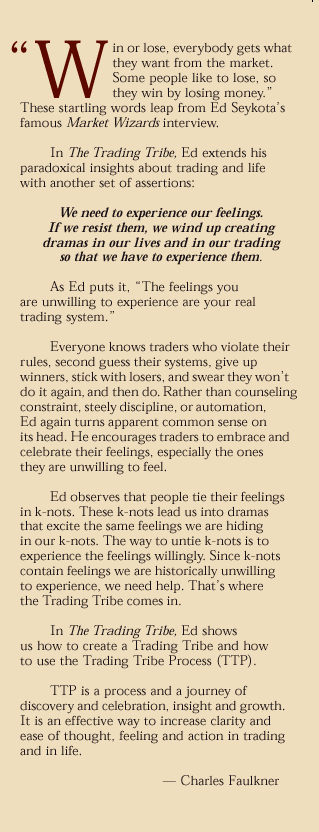Ed Seykota Trading Tribe Book Pdf
| Born | August 7, 1946 (age 72) |
|---|---|
| Occupation | commoditiestrader |
Edward Arthur Seykota (born August 7, 1946) is a commoditiestrader, who earned S.B. degrees in Electrical Engineering from MIT[1] and Management from the MIT Sloan School of Management, both in 1969. In 1970 he pioneered Systems trading by using early punched card computers to test ideas on trading the markets. Seykota resided in Incline Village, Nevada, on the north shore of Lake Tahoe, but recently moved to Texas.
Ed Seykota's FAQ (formerly: Frequently Appearing Questions) Home. Over the weekend I read The Trading Tribe book and get many AHA's as a result.

- 1Career
- 6Links
Career[edit]
Ed Seykota Quotes
As a young man he attended high school near The Hague, Netherlands and also lived in Voorburg.
Trading methods[edit]
Seykota is a trader who in 1970 pioneered a computerized trading system (now known as Trading System) for the futures market for the brokerage house he and Michael Marcus were working for. Later, he decided to venture out on his own and manage a few of his client's accounts.
Much of Seykota's success was attributed to his development and utilization of computerized trading systems to which he first tested on a mainframe IBM computer. Later on, the brokerage house he had been working for adopted his system for their trades.
His interest in creating a computerized system was spawned after he read a letter by Richard Donchian on utilizing mechanical trend following systems for trading and also Donchian's 5- and 20-day moving average system. He was also inspired by the book Reminiscences of a Stock Operator by Edwin Lefèvre. His first trading system was developed based on exponential moving averages.
Ed Seykota, Market Wizards
| “ | Systems don’t need to be changed. The trick is for a trader to develop a system with which he is compatible. | ” |

Seykota improved this system over time, adapting the system to fit his trading style and preferences. With the initial version of the system being rigid, he later introduced more rules into the system in addition to pattern triggers and money management algorithms.
Another aspect of his success was his genuine love for trading and his optimistic demeanour. This factor sustained his efforts to continuously improve on his system although he never changed the response indicators of the system and instead fine tuned market stimuli.
The Trading Tribe[edit]
In 1992, Seykota gathered together a group of traders to discuss their emotions, due to his concern that traders often allow their emotions to overrule their logic. The best of the bestest. They start gathering regularly and Seykota develops methods to support personal growth.[2] Over the years it expands to include Tribes all over the world and people in many professions. Members help to develop a common set of practices Seykota calls TTP, the Trading Tribe Process.[3] He describes these ideas and practices in his book The Trading Tribe (2005) and its refinement in an online article called TTP Extenstions: Replacing the Zero-Point Process with the Rocks Process (2013).[4]
Books[edit]
- The Trading Tribe (2005)
- Govopoly in the 39th Day (2013)
Influence[edit]
In Market Wizards, Updated: Interviews With Top Traders, author Jack D. Schwager devotes a chapter to Ed and writes that his 'achievements must certainly rank him as one of the best traders of our time.'[5] Some of Ed's students have included Michael Marcus, David Druz, Dean Giordano, Patrick Dougherty,Easan Katir,[6] and Jason Russell of Acorn Global Investments[7]Driver windows 7 ultimate.
Trader, instructor, and blogger Michael Martin is known to be one of Ed's protégés as well.[8] Mugen street fighter 4 lifebars download.
References[edit]
Ed Seykota Trading
- ^Pérez, Nieves. 'Ed Seykota: 6 reglas para triunfar en la bolsa y en la vida' (in Spanish). Retrieved 2018-08-21.
- ^Sekota, Ed. Govopoly in the 39th Day. p. 339.
- ^http://www.seykota.com/tt/2013/Apr/01-10/default.html
- ^Seykota, Ed (10 Dec 2013). 'TTP Extensions: Replacing the Zero-Point Process with the Rocks Process'(PDF). Seykota.com. Retrieved 2018-08-20.
- ^Schwager, Jack. Market Wizards, Updated: Interviews With Top Traders. Wiley. p. 151. ISBN1118273052.
- ^https://www.amazon.com/There-Tide-Easan-Katir-ebook/dp/B00MH8V8VS/ref=sr_1_1?ie=UTF8&qid=1446250971&sr=8-1&keywords=there+is+a+tide+easan+katir
- ^Covel, Michael (January 13, 2006). 'Learn from these up and coming traders'. The Connors Group. Archived from the original on November 24, 2006. Retrieved 2006-11-17.
- ^Covel, Michael. 'Trend Following'. Trend Following: Learn to Make Millions in Up or Down Markets. p. 64.
access-date=requiresurl=(help)
Links[edit]
- Elbe, Susan (October 11, 2000). 'Seykota expects 'No Excuses' for reading proficiency'. Zephyr staff. University of Nevada, Reno. Archived from the original on September 14, 2006. Retrieved 2006-09-04.
- Troseth, Eric (October 20, 2003). 'Can you forecast the market?'. Work & Money. The Christian Science Monitor. Retrieved 2006-09-04.
- Seykota, Ed; Dave Druz (March 1993). 'Determining Optimal Risk'. Stocks & Commodities magazine. Retrieved 2006-09-04.
Magazines[edit]
- Seykota, Ed (March 1991). 'MACD: sweet anticipation?'. Futures magazine. Retrieved 2006-08-23.
- Hartle, Thom (August 1992). 'Ed Seykota Of Technical Tools'. Stocks & Commodities magazine. Retrieved 2006-09-05.
- Collins, Daniel P. (November 2001). 'Turtles hatch'. Futures magazine. Retrieved 2006-08-23.

External links[edit]
| Wikiquote has quotations related to: Ed Seykota |
- 'Seykota's official home page'. 2006. Retrieved 2006-09-04.
- 'Seykota's Trading Tribe website'. 2006. Retrieved 2006-09-04.
- 'Seykota's Bernoulli challenge website'. 2006. Retrieved 2006-09-04.
- 'Listing Seykota's 'theory of radial momentum''. 2006. Retrieved 2006-09-04.
- 'Brief biography'. Profile. Master Mind Trader. 2006. Retrieved 2006-04-12.
- 'Curated Alpha: Curated Interview With Ed Seykota From Market Wizards'.
Further reading[edit]
- Schwager, Jack D. (1993). Market Wizards: Interviews with Top Traders. Collins. ISBN0-88730-610-1.
- Covel, Michael W. (2009). Trend Following (Updated Edition): Learn to Make Millions in Up or Down Markets. FT Press. ISBN0-13-702018-X.